IT MIGHT appear that we’re giving Steven Alldrick and the Deluxe Rod Shop a lot of ink lately, but that’s simply because they keep turning out killer hot rods and street machines. Most recently we featured Steven’s XR ute in SM, Apr ’20, and it was a huge hit. In a way, this ’32 roadster is a hot rod version of that car: understated, with a tendency towards factory styling features, but highly detailed top to bottom. I know many of you won’t believe it – and it sure as shit doesn’t look like it – but both cars were built with very tight budgets.
This article was first published in the July 2020 issue of Street Machine
Steven couldn’t be happier with the composite C&W Components body. The only work it needed was primer and blocking – no filler at all. The heavily raked Rodwell/Wanlass-style windscreen gives the car an aggressive demeanour
Of course, it helps when you have your own hot rod shop and spend a lot of time attending swap meets to source the cool early Ford parts that would make or break the look of the car. Even so, there are still plenty of areas where Steven invested time rather than money, and that’s something all of us can do. As with all of his builds, he simply had a plan and stuck with it: “We wanted to build a turn-key car in 60 days to showcase at the Victorian Hot Rod Show; something simple and a nice driver with the right look,” he says. “So after the XR was unveiled at Summernats 33, we didn’t stop – [wife] Kathleen and I did a lot of the assembly after work so we could keep the shop running and weren’t taking time away from customers’ cars.”
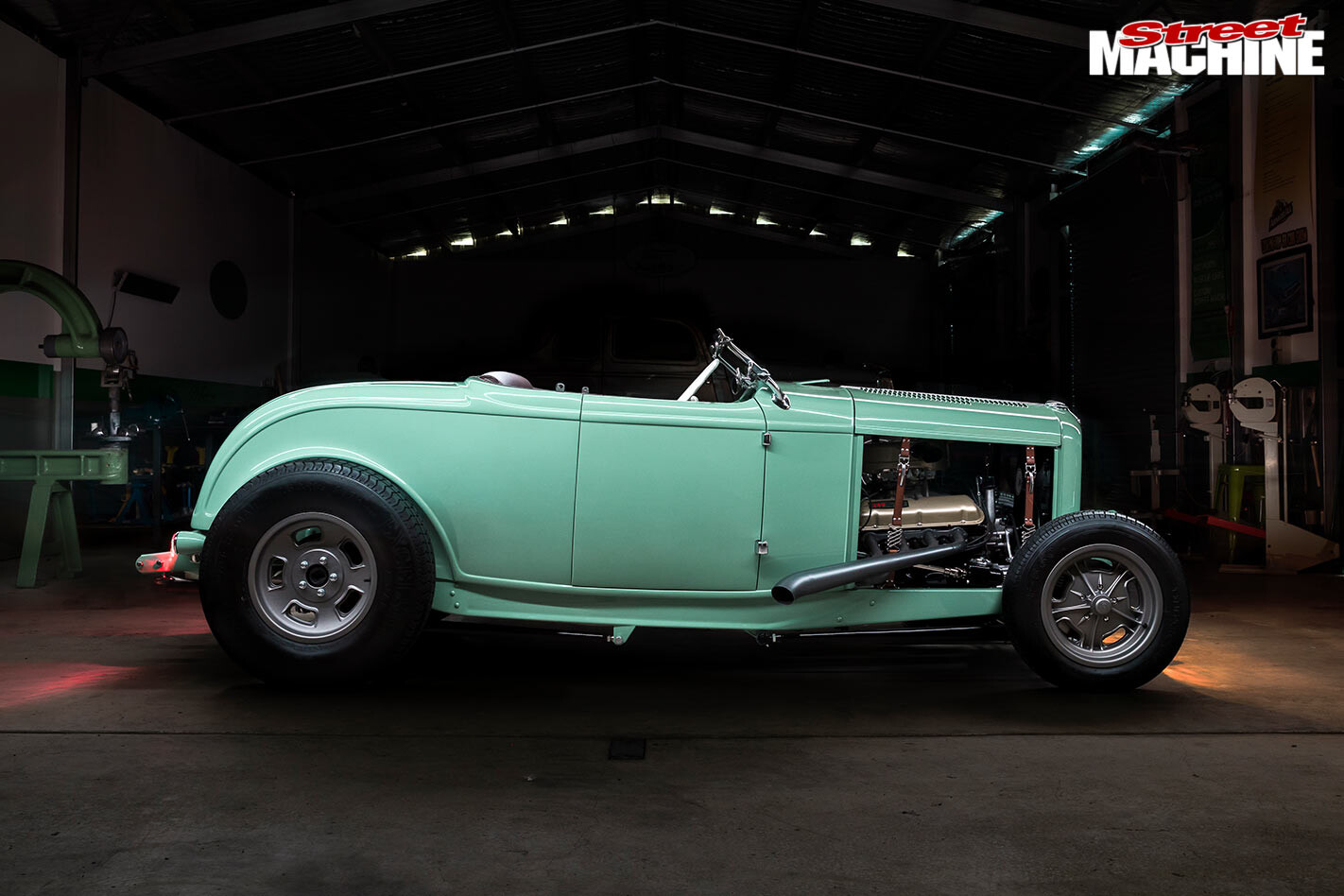
It’s all about the stance, which was built around the tall and skinny 16in Excelsior radials. To perfectly match the bodyline, the rear wheels were moved forward half an inch and the rake was achieved with 15in tyres up front and a flattened crossmember
After doing a bit of a stocktake in the workshop, it turned out they had most of the bits on hand to finish off the roadster. “I had a diff housing and a centre, all the radius rods, a set of Rod-Tech four-bars and coil-overs,” Steven says. “I only had to buy the axle and spring for the front end; I had everything else. We bought everything we needed during the build so there were no extra costs at the end.”
There are a few big-dollar items on the car, such as the wheels and tyres, windscreen and front axle. “I spent the money on the bits you can see,” Steven explains. “Things like the wheels and windscreen I had to have to get the look right. The windscreen is probably the most expensive thing on the car, but it needed it; it’s the same with the back tyres.”
Another neat trick of Steven’s was to combine old Ford parts with street rod parts to create the triangulated four-bar rear. “I used a ’46 radius rod flipped upside down, as it gets the car lower,” he explains. “I did the same on the back of Kathleen’s ’32 Ford tudor, and it worked so well because it’s still a four-bar but the bottom arm is longer. The front arms were ’34 radius rods that someone had cut up and attempted to split. I got some So-Cal tie-rod ends and TIG-welded them onto the end of the radius rods and saved them. One was a bit bent, so we heated it up and put it in the press to straighten it, then got them sandblasted.”
All of the suspension components and underside of the chassis were painted in gloss black, and it’s another area that looks a million bucks but was quite cost-effective. “It’s PPG industrial paint, so it’s hard-wearing and pretty cheap, but the shine out of it is just awesome,” Steven says. “Once our work experience kid polished all the bolts, it only took me and Kathleen a day to put the chassis together, because everything was polished and laid out ready to go.”
While Steven will tell you it’s not a show car, it’s still very tidy underneath. The suspension components have been painted in a heavy-duty, gloss-black finish from PPG that is usually used on trucks
Overall, there are very few shiny bits on the car. Whereas most people would be looking to fully polish the exhaust and wheels, Steven went in the exact opposite direction, having Oxytech powdercoat the lakes-style headers in a heat-proof titanium finish, while the wheels copped a magnesium-look coating. Even the mandrel-bent stainless exhaust has a brushed finish.
The interior is another area that looks like no expense was spared, but in actual fact there were lots of steps taken to save money. The leather hides were the last two in a discontinued line, so Steven got them for about a quarter of the price you’d normally pay. With a roadster there’s not much to trim anyway, but there was still a little left over after doing the seat, door trims and side panels in the boot.
More rubber flooring was used in the boot, with the leather saved for the side panels and battery box
Check out the carpet! Well, you can’t, because there isn’t any. It’s actually rubber flooring that you’d normally find in MGs and in the boots of early Aston Martins and Benzes, and it’s a lot cheaper than carpet. It also has the added benefit of being weatherproof – which is handy when you’ve got an open-topped car and you live in Victoria.
The seat is another area where Steve invested time instead of money: “It took me two days to build the seat, but the other option was to buy a Glide seat for a thousand bucks. It’s made from 19mm plywood with webbing so your bum falls into it and you sit quite low in the car.”
Steven has dressed up the late-model 5.0L engine to look like an early 289, even going to the trouble of fixing up an early 260 Windsor timing cover so he could run the oil fill tube. The air cleaner and rocker covers were swap-meet items that Steven paid $20 for, but then he spent 15 hours prepping and painting them
All the trim was done by Brendon Watts at North Central Motor Trimming, and it’s a beautiful job. At first glance I thought the seat and door inserts were some kind of fancy cloth trim out of a Cadillac, but it’s your good ol’ basket-weave vinyl from an XW Falcon.
Steven originally displayed the car as a rolling body and chassis and took it to a couple of swap meets, mainly to showcase the quality of the C&W Components composite body. While it may cost a bit more initially – $16,000 at the time of going to print – the time you save in bodywork means it more than pays for itself. “There’s not an ounce of bog in the whole thing,” Steven says. “The body has got four coats of primer on it; we blocked down the outside with 180-grit, then did the door and boot jambs with 600 and 800, guide-coated the outside again, then wet-rubbed and painted it. I painted the body in eight days start to finish, including a cut and buff. We’ve done five of their bodies now, and I can’t stress enough how good they are.”
Steven fabricated the lakes pipes, which were then coated with Oxytech Hi Temp Titanium. They feed into a twin 2.5in brushed-finish stainless system
The extra cost is also due to the higher-quality materials C&W uses, which are vinylester-based rather than polyester resins. The vinylester is much less prone to heat distortion, and the bodies are manufactured using a vacuum infusion process for the floor and firewall, which makes them much stronger and less prone to cracking.
Steven has copped a bit of flack over the colour, which looks quite similar to some other cars that have come out of the shop. “I had paint left over from my son Jake’s five-window that I built last year, my roadster and my ute, and they all got tipped in one bucket,” he says. “I copped a caning over it. I wanted it more blue and should have bought two litres to tip into it, but I was too tight for my own good!”
The interior is classy as hell, yet it didn’t break the bank. There’s leather on the doors and seat, but the inserts are XW Falcon saddle basket-weave. The carpet isn’t carpet at all; it’s actually rubber flooring usually found in open-top English sports cars
If you look at the specs box, you’ll see that Jake and his sister Zoe are listed as the car’s co-owners. They’re a ways off being able to drive it, but that hasn’t stopped them referring to it as their car! “We built it with the aim of selling it to ensure the kids have a good, secure future,” says Kathleen. So, while this one might be heading out the door, there are still plenty of cars in the shed to choose from, and no doubt plenty more in the future.
The ’38 Ford dash, while not as popular as a ’40, has just as much Art Deco cred. The wheel is from a ’46 Mercury, although it’s wearing a Ford horn rim in the photo
In fact, a ’34 five-window is already in the build – and Steven swears it will be orange! He also just happens to have a 429 big-block Ford lying around. I tell Steven I can already see it in my head: a bright orange, 60s-style ’34, heavy rake, rolling on polished Halibrands. “Don’t worry,” he replies, “I’ve already bought the wheels.”
JAKE & ZOE ALLDRICK
1932 FORD ROADSTER
Paint: Slops Bucket Blue
DONK
Type: Ford 5.0L
Inlet: Single-plane
Carb: Edelbrock 600cfm
Heads: GT40
Valves: 1.85in (in), 1.54in (ex)
Cam: Stock
Pistons: Stock
Crank: Stock
Conrods: Stock
Radiator: Walker
Exhaust: Lakes pipes with 2.5in stainless pipes
SHIFT
Transmission: C4
Converter: TCE 2500rpm stall
Diff: Ford 9in, 3.5:1 gears
BENEATH
Front end: Super Bell drilled I-beam, ’34 Ford split radius rods
Shocks: So-Cal tube (f), Rod-Tech coil-overs (r)
Steering: LimeWorks
Brakes: Ford discs (f), 10in drums (r)
ROLLING STOCK
Rims: American Rebel Starburst 15×4.5 (f), American Rebel Sprint 16×6 (r)
Rubber: Firestone 155R15 (f), Excelsior Stahl Sport Radial 7.50R16 (r)
THANKS
Barb and Andy at TCR Carponents; The Deluxe Rod Shop team: Jim Wolstencroft, Corey Scagg, Ron Mills and Lenny Souter; Brendon Watts at North Central Motor Trimming; Scott and Cam at SG Auto Electrics; Michael and Wally at C&W Components; Scott Barter at Oxytech Powder Coating
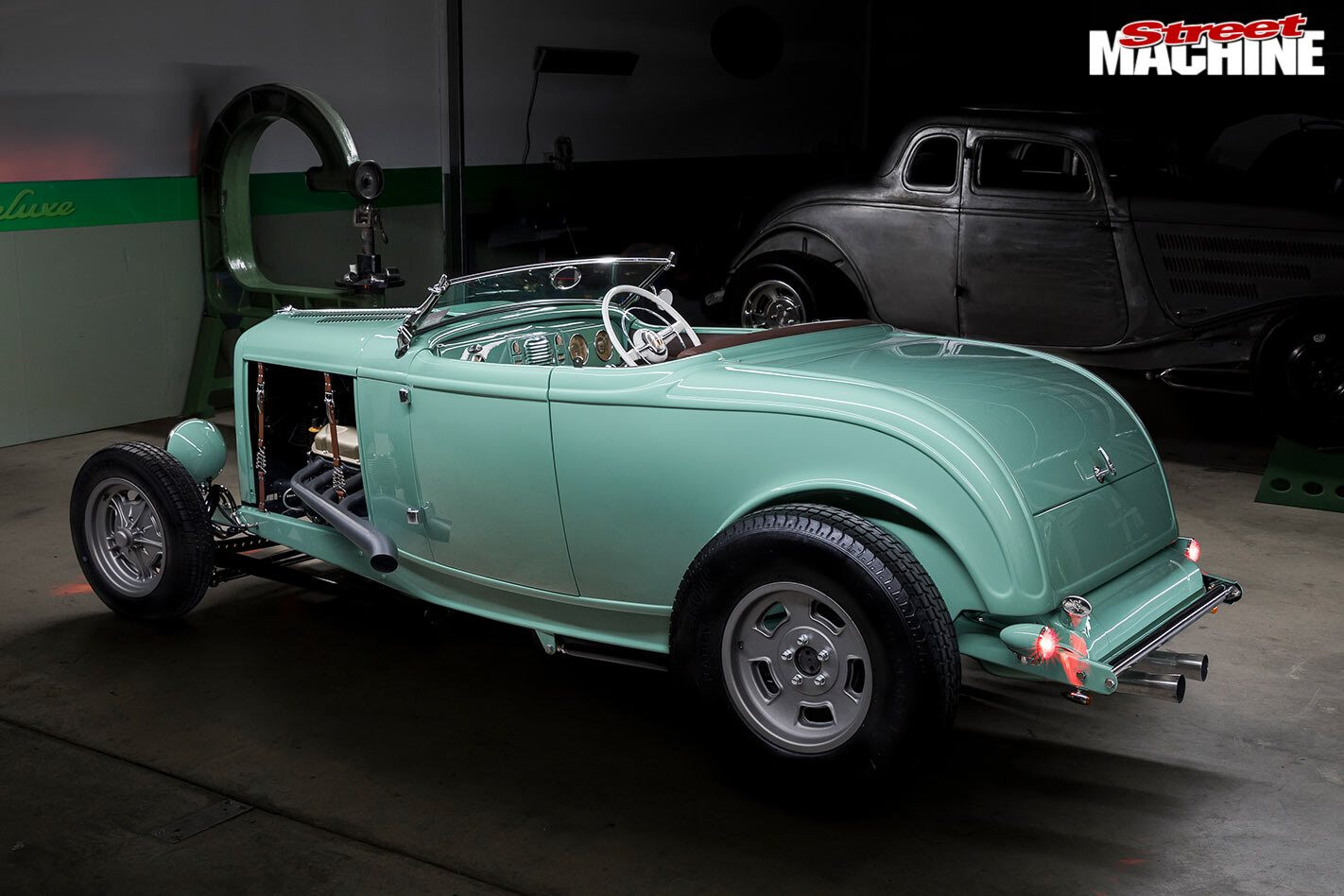
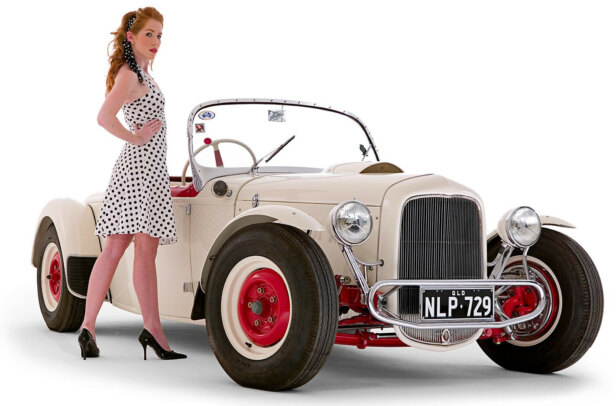
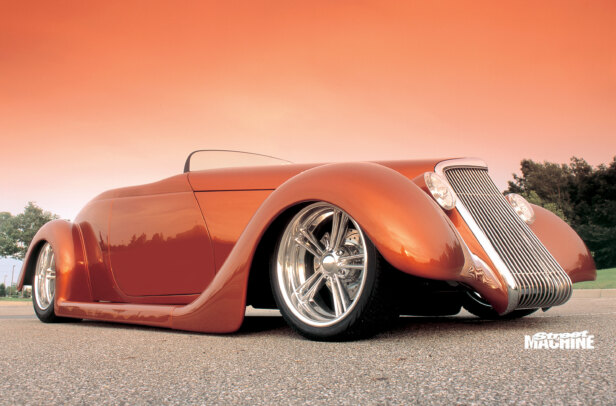
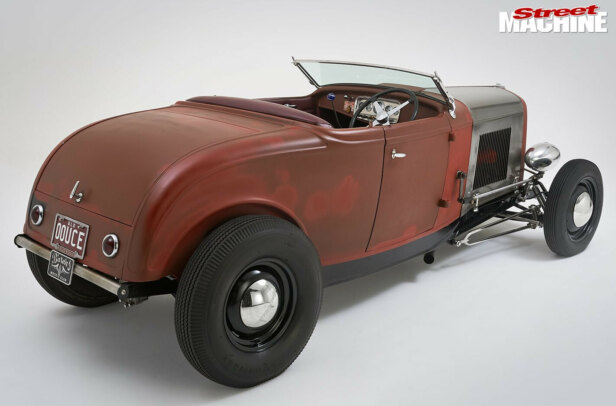
Comments